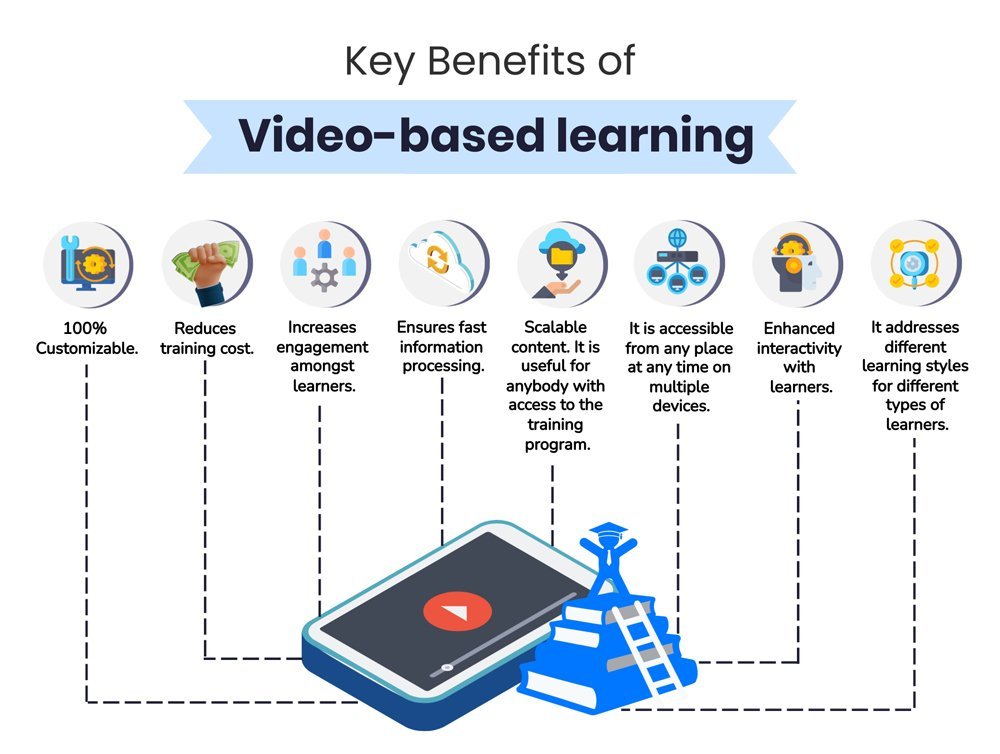The seven benefits of video-based corporate learning
Approximately 88% of large companies offer training via video broadcasting, webcasting, and virtual classrooms. And yet, up to 93% of training is still instructor-led, demonstrating a hesitance to accept the e-learning practices of which video-based learning is a part.
Traditional corporate training programs often take the form of somebody standing in front of a room of people to lecture them about the chosen subject. While this approach may be effective for some, it does not account for the fact that 65% of the population are visual learners. For these people, verbal or written training solutions will not prove as effective as more visual forms of education.
This is where video-based learning comes in.

In this article, we make the case that more organizations should create digital learning platforms like Learning Experience Platform(LXP) that incorporate video by highlighting the seven key benefits of video-based learning.
1 .Videos Are Customizable
No matter what topic a training video covers, you have full control over how the information is presented. This control means that you can easily edit or adjust videos when they’re out of date, as long as you can reshoot and edit.
What’s more, you’ll no longer find yourself relying on external trainers to deliver your training program. With video-based learning, you can create customized content that can be delivered directly via an e-learning platform or in an instructor-led classroom, depending on your preferences.
2. Lower Training Costs
Statistics show that 85% of every dollar that you spend on instructor-led training goes towards delivering the training. In other words, the majority of the money you spend is not related to the training program itself. Instead, it goes towards ensuring the instructor can travel to the required location or it pays for the instructor’s time.
The message here is that traditional training methods are costly. By contrast, the initial investment into creating videos and the appropriate LMS (Learning Management System) to host them is quickly outweighed by the money saved because of your ability to deliver these videos directly to the user.
3. Increased Engagement
According to a report conducted by research firm Forrester Research, your people are 75% more likely to view and engage with training videos than they are to engage with other forms of training, such as written documents and articles.
Engagement is key to effective training.
An unengaged trainee will not absorb the information being delivered to them, which means they’re less able to deliver on your organizational objectives. By using video training, you create a more engaged audience that takes more away from your training program.
4. Faster Information Processing
In the Psychology Today article Video vs. Text: The Brain Perspective, the magazine reveals that the human brain processes the information it receives from videos up to 60,000 times faster than it processes information received via text.
This point has enormous ramifications for any e-learning or web-based training programs that you deliver. Bombarding your trainees with pages upon pages of text may seem like a cost-effective method of teaching them. However, you may find that the far slower text processing time highlighted by Psychology Today could lead to your people learning business-critical concepts far more slowly than if they’d watched the same training material being delivered via video.
This is not to say that written training materials are redundant. Having written materials to refer back to, especially if they’re stored in an appropriate resource center within an LMS, can aid the learning process. But the research indicates that video is a far more effective educational medium when it comes to understanding concepts.
5. Scalability
As an organization grows, so does its training requirements. If you stick with traditional classroom-based training solutions, you also commit to increasing the cost of your training. What’s more, you will need to take larger numbers of your employees out of the working environment to engage in these classroom sessions.
Again, video training provides the solution.
With video, you have the option of creating entirely online training courses that can be perused at the viewer’s discretion. Building videos into a digital learning platform may also provide you with a way to track trainee progress automatically, especially if the videos are backed by online tests that record results. But perhaps most importantly, an LMS that incorporates video scales with the company. You do not need to make changes to how you deliver your training to account for having more people to train. Instead, the only changes you may potentially need to make are to ensure that everybody in the business has access to the training platform.
6. Video Can Be Accessed Anywhere
Imagine that you have organized an instructor-led session for 25 of your employees. However, five of them are unable to attend the session, be it due to illness, vacation, or simply because their workload does not allow them to. With a traditional training program, the session will have to be rearranged or the employee simply doesn’t attend and won’t receive the benefits of the training.
Either way, the organization loses out monetarily or due to an employee not having the information needed to be more productive.
Thanks to cloud-based technology and e-learning platforms, this issue can be solved with video learning. Assuming you host your videos on an appropriate platform, a trainee can access the content at any time, thus ensuring they don’t miss out.
7. Enhanced Interactivity
Game-based and interactive learning are shown to create a compound yearly growth rate of 53.4% for businesses. Furthermore, the microlearning made possible by more interactive mediums improves the performance of learners by up to 17%.
Videos can be interactive.
Many companies use choice-based video training that encourages trainees to answer questions as they watch the video. These questions challenge the user to draw on what the video has taught them to choose the correct course of action. This interactivity improves trainee performance and boosts information retention levels.
Video learning is the future.
Organizations have all of the tools required to create effective training videos that can become valuable parts of their e-learning platforms. And as this article demonstrates, the benefits in terms of engagement, information retention, cost-effectiveness, and scalability are clear to see.
The majority of people in your company are visual learners rather than text-based learners.
By using video to account for this fact, you can create a more effective training program that benefits your organization in several ways.

